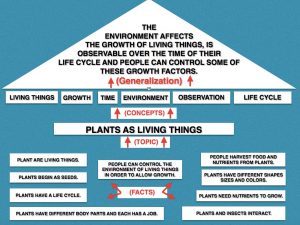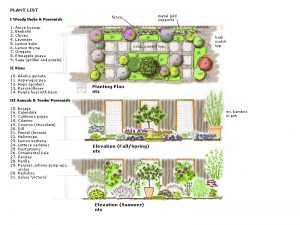The following diagram outlines The Structure of Knowledge framework for what I want the 4-5 year old children to know, understand and be able to do in our Plants as Living Things Unit.

AGE GROUP = 4-5 YEARS
UNIT TIME FRAME = 6 WEEKS

THE THREE DAYS OF LESSONS BELOW IS A “SNAPSHOT” OF A 6 WEEK UNIT WITH THE OVERALL OBJECTIVES OUTLINED ABOVE.
BEFORE :
THIS WILL HELP ASSESS WHAT THE CHILDREN KNOW ABOUT WHAT THEY EAT AND HOW IT GROWS.
DURING LUNCH FOR SEVERAL DAYS LEADING UP TO THE UNIT, THE TEACHER WILL ASK THE CHILDREN QUESTIONS REGARDING WHERE THEY THINK THEIR FOOD COMES FROM TO DETERMINE WHAT PRIOR KNOWLEDGE THE GROUP AND INDIVIDUALS IN THE GROUP POSSESS.
GUIDING QUESTIONS: WHAT FRUITS AND VEGETABLES ARE YOU EATING? DO YOU KNOW WHERE YOUR FOOD COMES FROM? WHAT HAPPENS WITH YOUR FOOD BEFORE IT GETS TO LA CASITA?
DAY 1: SEE-THINK-WONDER STRATEGY
CHILDREN WILL KNOW THAT PLANTS ARE LIVING THINGS.
CHILDREN WILL UNDERSTAND THAT LIVING THINGS GROW AND ARE AFFECTED BY DIFFERENT FACTORS.
CHILDREN WILL BE ABLE TO DRAW A PICTURE TO DEMONSTRATE THEIR KNOWLEDGE AND UNDERSTANDING.
STEP 1: WRITE THE WORD “LIVING THINGS” ON THE BOARD. ASK THE CHILDREN TO CLOSE THEIR EYES AND THINK ABOUT EXAMPLES OF LIVING THINGS. ASK THEM TO PAINT A PICTURE IN THEIR HEAD OF SEVERAL THINGS THAT ARE LIVING BECAUSE THEY ARE GOING TO HAVE A CHANCE TO DRAW THEM.
STEP 2: PLACE A 12X4 LARGE PIECE OF CHART PAPER ACROSS THE WALL OF THE CLASSROOM AND ASK THE CHILDREN TO DRAW THE EXAMPLES OF LIVING THINGS THEY PICTURED IN THEIR HEADS. AS CHILDREN DRAW, ASSIST THEM IN LABELING THEIR DRAWINGS.
STEP 3:ASK THE CHILDREN TO DO A GALLERY WALK (THIS NEEDS TO BE MODELED THROUGHOUT THE YEAR). AS THEY WALK TO VIEW OTHER’S DRAWINGS, THEY SHOULD FIND 1-2 DRAWINGS OF LIVING THINGS THEY HAD NOT THOUGHT ABOUT.
http://www.theteachertoolkit.com/index.php/tool/gallery-walk?wvideo=frn9ji37cn
STEP 4: GATHER THE CHILDREN TOGETHER AND LET THEM KNOW WE ARE GOING TO WATCH A VIDEO AND YOU WANT THEM TO DECIDE WHETHER OR NOT THE VIDEO WE ARE WATCHING SHOWS A LIVING THING OR A NON-LIVING THING AND WE WILL DISCUSS WHY ALONG THE WAY. CHILDREN WILL SHARE OUT LOUD AND TURN AND TALK TO PARTNERS DURING DISCUSSION.
PLAY THE FIRST MINUTE OF THE VIDEO LINKED BELOW. THEN STOP THE VIDEO AND ASK THE QUESTIONS ABOVE TO THE CHILDREN. ASK WHAT DO YOU SEE?
THEN PLAY THE NEXT MINUTE AND STOP AND ASK THE QUESTIONS. ASK IF THERE IS ANYTHING THEY SAW IN THE SECOND SEGMENT THAT WAS DIFFERENT THAN THE FIRST. ASK WHAT DO YOU THINK?
REPEAT UNTIL VIDEO FINISHES. ASK WHAT DO YOU WONDER?
THEN SHOW THE VIDEO AGAIN FROM START TO FINISH WITHOUT STOPPING.
ASSESSMENT: CHILDREN DRAWINGS, DISCUSSIONS, GALLERY WALK
DAY 2: STRATEGY: I USED TO THINK….NOW I THINK…
STEP 1) TELL CHILDREN THAT WE ARE GOING TO GROW FOOD TO EAT. NAME OFF SOME OF THE FOODS YOU’VE OBSERVED THEM BEING INTERESTED IN THAT WE ARE GOING TO GROW. ASK HOW THEY THINK WE GROW FOOD. LEAD A DISCUSSION ON WHAT DO YOU THINK A SEED IS? OPEN DISCUSSION (RECORD WHAT CHILDREN SHARE)
READ ALOUD ERIC CARLE’S THE TINY SEED.
https://www.youtube.com/watch?v=CeIGNOFW6n0
STEP 2) AFTER CONSISTENT MODELING OF THE STRATEGY, USE I USED TO THINK……, NOW I THINK
HAVE CHILDREN DRAW A PICTURE; ON ONE SIDE DRAW WHAT THEY USED TO THINK A SEED WAS AND ON THE OTHER SIDE WHAT THEY NOW KNOW A SEED TO BE.
STEP 3) STUDENTS SHARE ARTWORK AND TEACHER LABELS WHAT THEY SAY ON THEIR ARTWORK.
ASSESSMENT: USE ARTWORK AND CHILDREN’S VERBAL DESCRIPTIONS.
DAY 3: STRATEGY:3-2-1 Bridge (This should be modeled and practiced many times for it to be effective.)
STEP 1) THE TEACHER WILL GATHER SEEDS FROM THE VARIOUS FOODS CHILDREN EAT AND PUT ON ELMO MACHINE WITH CHILDREN GATHERED AROUND ON THE CARPET.
STEP 2) Using a “Turn and Talk” with a partner. Children will identity a word the seeds make them think of, then share, then other child share word, and keep going until their minds can’t think of any more words. Children will identify a question they have about the seeds and turn and share.Children will identify a metaphor or simile for the seeds.Teacher: Record Observations
3) AFTER DETAILED MODELING BY THE TEACHER, CHILDREN WILL BE SEPARATED INTO GROUPS OF 3, GIVEN A CONTAINER OF VARIOUS SIZE, SHAPE AND COLOR SEEDS AND ASKED TO SORT THEM BY DIFFERENT ATTRIBUTES. THEY WILL RECORD THE QUANTITIES OF THE VARIOUS TYPES OF SEEDS ON A LARGE CHART PAPER GRAPH.
ASSESSMENT: DISCUSSION, TURN AND TALK OBSERVATIONS AND GRAPH SHOWING VARIOUS ATTRIBUTES.
DAY 4: STRATEGY:
STEP 1) TELL CHILDREN WE ARE GOING TO PLANT SEEDS AND OBSERVE THEM OVER TIME RECORDING WHAT WE SEE OVER THE NEXT WEEKS.THEN WE ARE GOING TO EAT THEM FOR LUNCH. ALLOW TIME FOR AWWWS AND OOOHHHHS:)
STEP 2) DEMONSTRATE HOW TO PLANT A SEED AND ASK STUDENTS TO CHOOSE WHICH SEED THEY WANT TO PLANT AND PLANT THE SEEDS IN EGG CARTONS.
STEP 3) TELL CHILDREN SOME OF THE SEEDS WILL GO IN THE WINDOW SILL, SOME WILL GO IN A DARK SPACE WITH NO LIGHT. SOME WILL GO IN A VERY COLD SPACE AND SOME WILL GO IN A VERY WARM SPACE. WE WILL WATER SOME OF THE SEEDS A LITTLE AND SOME OF THE SEEDS WILL HAVE LOTS OF WATER. THEN WE ARE GOING TO DISCOVER WHETHER HAVING LIGHT, A CERTAIN TEMPERATURE AND CERTAIN AMOUNT OF WATER SEEMS TO AFFECT THE GROWTH OF THE PLANTS. HAVE THE CHILDREN HELP TO DETERMINE WHO PUTS THEIR SEEDS WHERE AND THEN PLACE THEM IN THE DESIGNATED SPOTS.
STEP 4) TALK WITH THE CHILDREN ABOUT WHAT BEING A SCIENTIST MEANS AND PREPARE OBSERVATION NOTEBOOKS AND SCIENTIST LAB COATS FOR DAILY OBSERVATIONS.
ASSESSMENT: DISCUSSION, SEED/EGG CARTON, NOTEBOOK READY
AFTER:
CHILDREN WILL RECORD DAILY OBSERVATIONS, AND USING OTHER MTV STRATEGIES THROUGHOUT THE UNIT, ALONG WITH THE UNIT CONCEPTS AND LEARNING STANDARDS, EXPLORE THE LIFE CYCLE OF PLANTS, MAKING PREDICTIONS, OBSERVATIONS AND AND REPRESENTATIONS OF THEIR LEARNING ALONG THE WAY. CHILDREN WILL DESIGN A GARDEN AND PLANT THIER SEEDLINGS IN THE GARDEN CONTINUING THEIR OBSERVATIONS OUTSIDE. THE CULMINATING LESSON WILL BE AN INVITATION TO OUR PARENTS AND FAMILIES FOR LUNCH (THIS WILL NEED TO OCCUR WHEN THE FOOD IS READY FOR PICKING WHICH WILL MOST LIKELY BE BEYOND THE 6 WEEK UNIT TIMEFRAME). OUR CHILDREN WILL PREPARE AND SERVE THEIR FAMILIES LUNCH FROM THE GARDEN.







Usually I recommend narrowing an e-business focus rather than broadening it, since it’s much easier for small players to succeed with a niche approach, than offering a product or service that tries to be all things to all people and ends up very shallow.
Jerseys NFL Cheap
W.
Cheap Stitched Jerseys
For Jordan and gregg popovich comments James never hit back, but just yesterday in the knight’s basketball stadium set aside a James training video, far look like illusions emerged both Owen, a carefully look just know is James
birkenstock shoes
Concept Based Curriculum & Instruction-Prince | EDT 622
sdnscqilmh http://www.gyn391dtp66r425my4o2cxq35i3o069is.org/
asdnscqilmh
[url=http://www.gyn391dtp66r425my4o2cxq35i3o069is.org/]usdnscqilmh[/url]
Elizabeth,
I’m so interested in your concept now! I believe your See-Think-Wonder activity and your video of living and non-living things will set students up strongly to communicate what their understanding of living things is. You’ve done a beautiful job of allowing them the freedom to share and “fail” by getting things wrong. It’s even more exciting to think about the deep thought process that is occurring for students and how much growth could come from their little “failures” along the way as they expose them. You have so many visually appealing graphics! You may want to consider enlarging them as you share these plans with others that want to see details and make copies of the resources you provide. Great work!
Hi Kenzie,
Thanks for the feedback! I agree on the enlarging the graphics…I tried for an hour and couldn’t figure out how to get them enlarged and posted….Do you have any tips?
Thanks.
Beth
Hi Beth,
I liked seeing how you incorporated the MTV strategies into your lesson. I can really see how you plan to use them regularly in your classroom. Having the students grow a garden will be great to help them create a relationship with where their food comes from and how it develops. My favorite part of your lesson is how you plan to have students draw what they thought before verse what they think after, I think its a great way to have the students communicate their understanding.
Thanks Natasha…..
Hello Elizabeth. I really enjoyed reading through your lessons. Having dealt with high school students for so long, your lessons were refreshing to see. I was impressed with the detail involved and how you let the students draw their ideas, and then you put words to them as they explained. I am sure you will enjoy them talking about what they eat and where they think it comes from. I’d like to be a fly on the wall for that part. Stopping the video every minute to allow the students to process what they saw is a great way to increase their understanding, allowing them to discuss it and ask questions before something else comes up on the screen and they forget what they wanted to ask. I sometimes think I should do that more with high school students.The whole unit does a great job of getting them involved and some ownership as they learn some valuable lessons. I just have one question, and it may be showing my age… In Day 3, Step one, what does “put on elmo machine” mean?
Great job.
Hi Chris,
Thanks for the message. Stopping and breaking things up with high school students when watching a video would work with them too I think Great idea….The Elmo machine is a machine where we can put an object on it and then it projects the object on the wall through a projector. It is a great way to have a group of students really see something as it is in color as well.
Hi Elizabeth, I really enjoyed reading your lessons! I especially liked your part about whether something is living or nonliving and the Youtube video of the pumpkin growing. I found myself watching three other videos of vegetables growing… I think young students would think those videos were neat. You also had a lot of detail in a all of your steps which is great to see. Someone could easily use your ideas in their own classroom. Thanks, Lauren.
Thanks Lauren…..It is amazing to see the plants grow on the time lapse videos….I found myself finding more and more as well….
Elizabeth, this sounds so fun! I really like that you’re going to use their lunches to jumpstart their discussions since it is something very relateable to them. For the final piece of this unit, will the students design the garden together or will this be done individually? One additional twist that you could add to this would be to have students plan their gardens individually (use this as assessment), then do a gallery walk of their plans. This could be used to plan the class garden, pulling from students’ ideas.
Hi and thanks for the feedback!! I planned to have each individual student sketch out their garden based upon what they wanted to plant in it and then work in groups to “merge” what they have to create one for their group. The gallery walk is a great idea….